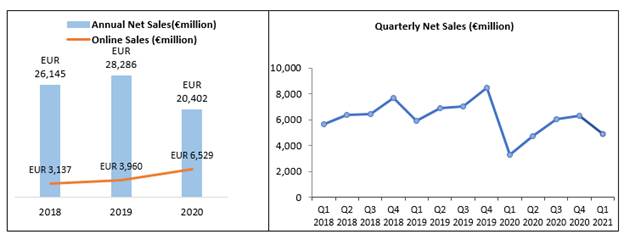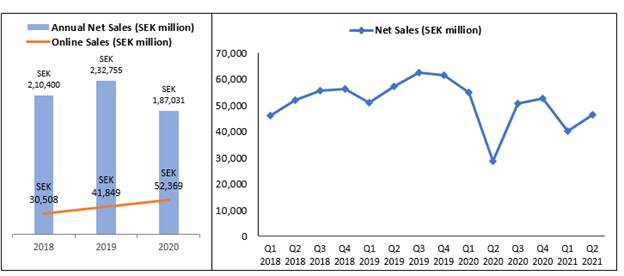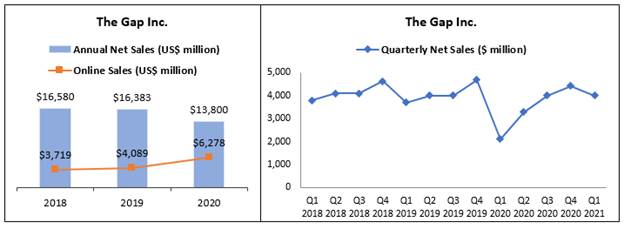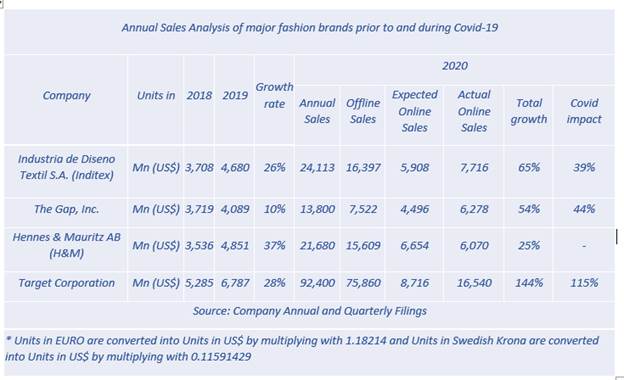There has been a sharp decline in annual net sales of companies for the year 2020 due to the adverse impact of the Covid-19 pandemic world over. But on a brighter side--there has been a remarkable growth in online sales in the last one year as the world gyrated more towards technology which transformed the business models of companies forever.
Year 2020 will remain etched in world history as the year of the pandemic and the resultant digital transformation it has brought about in the socio-economic landscape.
2020 was marked by social crisis, market recessions and a slew of other hardships. The only bright spot was the dawning of the digital era--where most operations within a business framework went digital.
Prior to the outbreak, people bought certain necessities like groceries, clothes, gadgets, home appliances etc directly from the physical stores as they wanted to be sure about their quality and see whether they matched their expectations. Thus, people had the tendency to have a first-hand feel of the product before buying it. But the lockdowns in several cities of the world during the initial phase of the pandemic in 2020, forced people to buy online. In such a scenario, people were left with no other choice but to buy online even if they were unsure of a product’s quality.
Soon, this forced move turned into convenience and online platforms started gaining credibility. This lead to behavioural changes among consumers who moved to online marketplaces and thus paved the way for the new digital era. Social activities being still restricted makes online buying a preferred option even today and this is going to continue in the future.
Looking back at last year, one realises every individual, business, industry and the world as a whole was impacted by the pandemic. Even the global fashion industry was not left behind. The complete or partial shutdown of brick-and-mortar fashion stores, schools and workplaces, excess inventory levels at stores, supply chain disruptions had adversely impacted the sales of fashion brands.
Soon online stores of brands or their digital presence came to the rescue and helped maintain sales of fashion brands at the optimum level.
Major fashion brands have reported decrease in the overall net sales in year 2020 due to a sharp decrease in offline sales (physical stores). But nonetheless, lowered digital barriers to entry has led to exponential growth in online sales.
Spanish top fashion brand- Inditex, revealed that due to Covid-19, its annual revenue of year 2020 has contracted and was contained at 24.5 per cent, stripping out currency effects, with online sales registering a strong growth of 77 per cent in constant currency to €6.6 billion. The online visits also doubled to 5.3 billion in 2020, with 132 million users of Inditex apps worldwide. The online sales increased to 32 per cent from 14 per cent of last year (2019).

Net Sales data of Industria de Diseno Textil S.A. (Inditex) for the years 2018, 2019, 2020 and 2021
Similarly, top Japanese fashion brand--Fast Retailing has also reported that in FY2020, online sales for the whole Fast Retailing group topped ¥300 billion, representing approximately 15 per cent of total annual sales. They now plan to expand this to 30 per cent in the future.
One of the leading Swedish clothing brands--Hennes & Mauritz (H&M) AB also declared that its online sales increased by 50 per cent in local currency in the fourth quarter of 2020 compared to the same period of the previous year and by 38 per cent for fiscal 2020. However, net sales of the second quarter of 2020 (March-April), were hard hit as a result of widespread pandemic, due to which the annual sales had sharply declined. Thus the growth in online sales was absorbed by the overall sales decline.

Net Sales data of H & M Hennes & Mauritz AB) for the years 2018,2019, 2020 and 2021
Similarly, US-based clothing brand The Gap Inc states that their net sales for fiscal 2020 decreased to $2.6 billion, or 16 per cent, compared to fiscal 2019, reflecting a 39 per cent decline in store sales, partially offset by a 54 per cent increase in online sales. The decrease in net sales was primarily driven by mandatory store closures and stay-at-home restrictions due to COVID-19. Although COVID-19 negatively affected their store sales for fiscal 2020, their online sales increased significantly compared to fiscal 2019.

Impact of Covid-19 on Annual Sales of the year 2020
Calculation: Expected Online sales 2020 = % growth rate of 2019* Net Online sales of 2019
Covid Impact = Actual growth rate- Expected growth rate of 2020

Post Covid Scenario
The pandemic has changed customers' behaviours and as a result, fashion brands have changed focus on their online business to serve customer demand by leveraging the power of digital capabilities.
According to a new McKinsey Global survey, companies have accelerated the digitalisation of their customer and supply-chain interactions and their internal operations by three to four years.
Likewise, the Q1 2020 report of Inditex reveals that the company is expecting online sales as a percentage of total sales to rise continuously over the long-term and may exceed 25 per cent of total sales by the end of 2022. The group also expects to invest 1 billion euros in online capital expenditure for the period 2020 to 2022 to achieve its ultimate aim of accomplishing full digitalisation of its stores globally.
Similarly, Fast Retailing has also declared its goal of expanding online sales to 30 per cent in the future, which will boost a global network of over 3,000 stores. It also wants to rebuild its business platforms in individual markets to increase synergies between stores and e-commerce. It will also proactively invest and secure the human resources required to expand its e-commerce business.








Comments